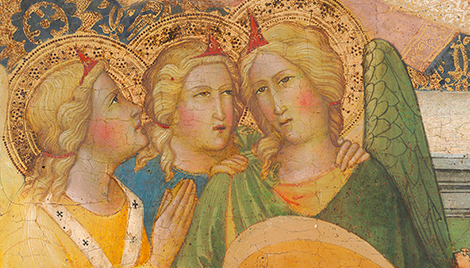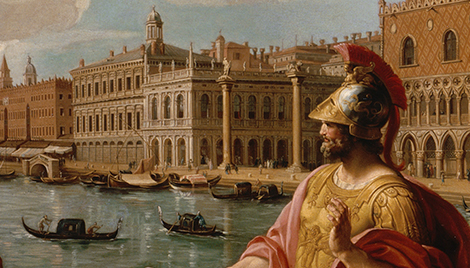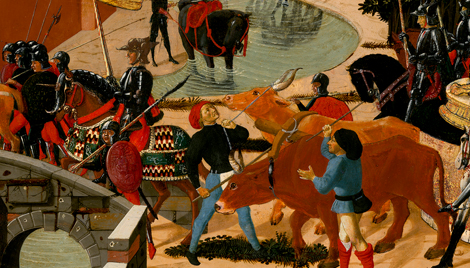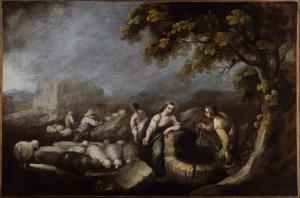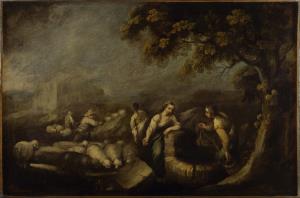Jacob and Rachel at the Well
Jacob and Rachel at the Well
- Artist
- Francisco Antolinez y Sarabia
- Artist Dates
- 1644-1700
- Artist Nationality
- Spanish
- Title
- Jacob and Rachel at the Well
- Date
- around mid-1670s
- Medium
- oil on canvas
- Dimensions
- 48.9 x 73.7 cm (19-1/4 x 29 in)
- K Number
- K484
- Repository
- El Paso Museum of Art
- Accession Number
- 1961.1.55
- Notes
Provenance
Jean-Joseph-Pierre-Augustin Lapeyrière [1779-1831; (Lapeyrière sale, Galerie Le Brun, Paris, 19 April 1825, no. 58); bought by Henry (?). [1] Rt. Hon. George Augustus Frederick Cavendish-Bentinck [d. 1891] London. Sir Henry Hawley [d. 1919] Hove, Sussex, England; (sale, Christie's, London, 16 April 1919, no. 27 as Murillo, Landscape with Figures and Sheep near a Well); bought by Nicholson. [2] Dr. A. Martin, London. Eugen Boross by 1923 until at least 1935, as Murillo. (Kleinberger Galleries, New York); sold to Samuel H. Kress [1863-1955] in 1937; gift to El Paso Museum of Art in 1961, no. 1961.1.55. [1] Annotated sales catalogue in National Gallery of Art library is somewhat illegible, but appears to read Henry. [2] Buyer according to annotated auctioneer catalogue, Christie's Archive, London.
Catalogue Entry
Francisco Antolinez y Sarabia
Jacob and Rachel at the Well
K484
El Paso, Texas, El Paso Museum of Art (61-1-55), since 1961. Oil on coarse canvas. 19 1/4 x 29 in. (48.9 x 73.7 cm.). Relined, cleaned and restored by Pichetto in 1938. El Paso, 1961, Cat. No. 47. Jacob is shown at the right, about to water his uncle's flock with the well bucket in his hand. He has just met Rachel, who leans upon masonry at the well head (Genesis 29:10-11). To the left sheep are drinking from the trough. The rock which Jacob removed from the well opening lies in the center foreground. Two shepherds are in the background where a large house is seen. An impressionistically rendered tree is in the right foreground. A female figure, seen from the back, behind Rachel, may be her sister Leah.(1) Between 1826, when K484 was first published in the famous Lapeyrière sale, and 1961, the painting was always regarded as by Murillo. A certificate to this effect was prepared by Mayer in 1922.(2) In the same year Térey described K484 as 'apparently a study for a great painting, which was lost, and may have belonged to the series representing the life of Jacob'.(3) The series referred to by Térey was painted by Murillo in the late 1660s.(4) The Kress canvas was characterized by Burroughs as a 'silvery and poetic little picture ... one of his [Murillo's] rare landscapes, with smallish figures representing Jacob and Rachel'.(5) In 1937 A. Venturi, F. Mason-Perkins, William Suida, and G. Fiocco supported a Murillo attribution for K484.(6) Gudiol suggested a dating of 1665 for this work, which he gave to Murillo.(7) Gaya Nuño (p. 255, Cat. No. 2000) believed Murillo to have painted it toward 1670. Shapley first published the canvas as by Francisco Antolínez y Sarabia, noting its stylistic similarity to that master's series of scenes from the Life of the Virgin (Madrid, Prado). She found that Rachel is painted with 'the grace of Murillo ... at least this detail of the picture should be re-attributed to this master. Possibly the picture dates from the mid-1670s when Antolinez was in Murillo's drawing school in Seville' (El Paso, loc. cit.).(8) Stechow suggested the Kress canvas may be by Ignacio de Yriarte. Three years Murillo's junior, Yriarte, according to Soria and Stechow, may have influenced the better-known Seville master's approach to landscape.(9) The landscape section of K484 is close in style and feeling to a depiction of the same subject (Ponce, Museo de Arte, Puerto Rico) by José Antolínez, the uncle of the master of the Kress canvas. José was a pupil of the Seville landscape master Yriarte.(10) Nine years his nephew's senior, Antolínez was active in Madrid. Both uncle and nephew worked in a manner somewhat like that of Murillo. The Ponce painting is entitled Landscape with Shepherds but may, like the Kress example, belong to the category of Paisajes de la Sagrada Escritura. Jacob and Rachel at the Well resembles a series of three canvases of the same religious genre in Seville Cathedral by Francisco Antolínez, but the figures in the Kress canvas are more literal, less romantically and freely rendered. The attribution of K484 to Francisco Antolínez y Sarabia is not entirely conclusive. However, it is more satisfactory than the previous suggestions –Murillo and Yriarte. The figures are insufficiently authoritative for the first and the landscape seems too conventional in execution for the second. Antolínez y Sarabia, an eclectic painter, may well have combined the style of Yriarte, who was his uncle's teacher, with that of Murillo, whose works dominated the School of Seville in the later seventeenth century. Provenance: All of the following catalogues give K484 to Murillo. Lepeyrière, Paris (sale, Paris, Le Brun Galerie, Catalogue des Tableaux et autres objets de curiosite formant le Cabinet de M. Lepeyrière, 19 Apr. [1825], pp. 37-8, Cat. No. 58, as Paysage pastorale). G. A. F. Cavendish Bentinck.(11) Sir Henry Hawley, Hove, Sussex, England (sale, London, Christie's, 16 Apr. 1919, p. 6, Cat. No.7). A. Martin, London.(12) Eugen Boross, as early as 1923, exhibited –New York, Metropolitan Museum of Art, Spanish Paintings from El Greco to Goya, 1928, p. 44. Brooklyn, New York, Brooklyn Museum, Exhibition of Spanish Painting, 1935, Cat. No. 48. New York, Kleinberger Gallery. Kress acquisition 1937, exhibited –New York, New York World's Fair, Masterpieces of Art, Catalogue of European and American Paintings, 1940, p. 89, Cat. No. 120. Toronto, Art Gallery, All Exhibition of Great Paintings in Aid of the Canadian Red Cross, 1940, p. 11, Cat. No. 53. Toledo, Ohio, Toledo Museum of Art, Spanish Painting, 1941, pp. 114-16, Cat. No. 45. Montreal, The Montreal Museum of Fine Arts, 1952, p. 20, Cat. No. 20.
References
(1) For representations of this subject see Réau, II, I, pp. 148-50; Anton Pigler, Barockthemen, Berlin and Budapest, 1956, I, pp. 59-62. (2) 19/IV/22, transcription in Kress Archive, New York. (3) Gabriel de Térey, 'Die Murillo -Bilder der Sammlung Eugen Boross in Larchmond', Cicerone, XV, Sept. 1923, pp. 769-74. (4) See Wolfgang Stechow, 'Bartolome Esteban Murillo, Laban Searching for his Stolen Household Gods in Rachel's Tent', Bulletin of the Cleveland Museum of Art, Dec. 1966, pp. 367-77. Murillo's canvas of Jacob Meeting Rachel at the Well is lost. It was last recorded in the Alexis Delahante sale of 1817. See Charles B. Curtis, Velazquez and Murillo, London and New York, 1883, p. 119, Cat. No. 8b. (5) Bryson Burroughs, 'Spanish Paintings from El Greco to Goya', Bulletin of the Metropolitan Museum of Art, XXIII, 1928, pp. 39-44, p. 44. (6) Transcriptions in Kress Archive, New York. (7) Jose Gudiol, Spanish Painting, Museum of Art, Toledo, Ohio, 1941, p. 114. (8) Evidence for Antolínez y Sarabia's execution of a Jacob cycle may be found in his drawing for a Jacob Wrestling with the Angel (Hamburg, Kunsthalle). (9) Stechow, op. cit., p. 375. George Kubler and Martin Soria, Art and Architecture in Spain and Portugal and their American Dominions 1500-1800, Baltimore, 1959, p. 277. (10) Julius S. Held, Catalogue of the European and American Schools, Museo de Arte de Ponce, Ponce, 1965, I, p. 5. The subject appears to be The Peeling of the Wands, based upon the Murillo now in a Swiss private collection (reproduced by Wolfgang Stechow, op. cit., fig. 6). (11) According to dealer's brochure. Neither the 8-11, 13-14 July 1891 nor 15-17 July 1891 sales (London, Christie's) of the G. A. F. Cavendish Bentinck Collection mentions K484. (12) According to Térey, op. cit., p. 770.

